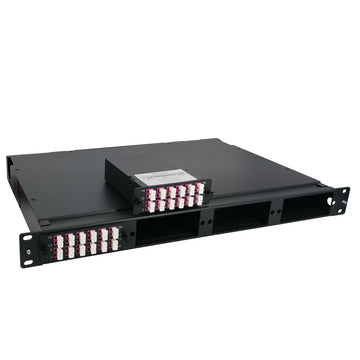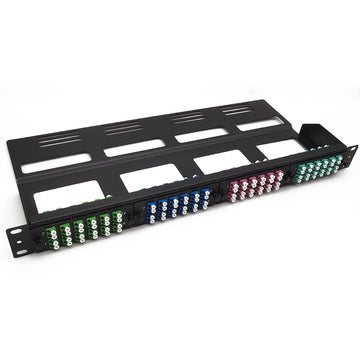Fiber Optic Cable Types: Single Mode vs Multimode Fiber Cable
Single Mode and multimode Fiber Cable, both these types of optical fibers have their own attributes and are used as per the specific requirements. The differences between single mode and multimode fiber optic cable mainly lie in fiber core diameter, wavelength & light source, bandwidth, color sheath, distance and cost.
An optical fiber consists of a core surrounded by cladding where the core is the denser medium and cladding is the relatively rarer medium. On the basis of the mode of propagation of light there are two kinds of fiber cables:
Single-mode Fiber Optic Cables
Single-Mode Fibers (SMF) is the fiber cable that is designed to carry only a single mode of light that is the transverse mode. These are used for the long-distance transmission of signals. Single mode fiber’s core size is smaller and carries light directly down the fiber (it only allows the fundamental mode of light to transmit down the fiber). As a result, light reflection created during light transmission decreases, lowering attenuation and allowing the signal to successfully travel over longer distances.

Multimude Fiber Optic Cables
Multimode optical fiber (MMF) is a type of optical fiber mostly used for communication over short distances, such as within a building or on a campus, that can transmit data via their core of larger diameters enable an average, single-mode transceiver multiple modes of light to propagate through it. However, this limits the maximum length of transmission links possible due to modal dispersion. These fibers are thus used for the short-distance transmission of signals.
- Half Duplex Fiber Optic Cables
Half duplex fiber optic cable is capable of sending the signal in both directions but in only one direction at a time. Some transmission network uses half duplex cables but it is necessary to specify this requirement for all the nodes in the network. For instance, half duplex fiber optic can be used in police car radio phones to allow only one person to talk at each time.
- FullDuplex Fiber Optic Cables
In the full duplex fiber optic cables, the data is transferred in two different directions simultaneously on a single carrier at the same time. An example is a telephone IP service where people at both ends of a call can speak and be heard by each other at the same time because there are two communication paths between them, thus using the full duplex mode can increase the efficiency of communication.

Overview of Single Mode vs Multi-mode Fiber Optic Cable
Core Diameter
There is a major difference in their built too. The main difference between multimode and single mode fiber is that the former has much larger core diameter, typically has a core diameter of 50 or 62.5 µm and a cladding diameter of 125 µm. While a typical single mode fiber has a core diameter between 8 and 10 µm and a cladding diameter of 125 µm.

Wavelength & Light Source
Due to the large core size of multimode fiber, some low-cost light sources like LEDs (light-emitting diodes) and VCSELs (vertical cavity surface-emitting lasers) that works at the 850nm and 1300nm wavelength are used in multimode fiber cables. While the single mode fiber often uses a laser or laser diodes to produce light injected into the cable. Laser light sources are significantly more expensive than LED light sources however they produce a light that can be precisely controlled and which has a high power. Because the LED light sources produce a more dispersed light source (many modes of light) these light sources are used with multimode cable. While a laser source is used (which produces close to a single mode of light) with single mode cable.
Bandwidth
Multimode fiber bandwidth is limited by its light mode and the maximum bandwidth at present is 28000MHz*km of OM5 fiber. While single mode fiber bandwidth is unlimited theoretically because it allows only one light mode to pass through at a time.
Single Mode vs Multimode Cable Types
When you see mentions of OM1, OM2, OM3, OM4 and OM5, you know you’re talking multimode fiber. But it’s not quite as simple with single mode fiber. Today’s types of single mode fiber include:
- Standard singlemode fiber (G.652)
- Cutoff shifted fiber (G.654)
- Low water peak fiber (G.652)
- Dispersion shifted fiber (G.653)
- Non-zero dispersion shifted fiber (G.655)
- Bend-insensitive fiber (G.657)
Each type of single mode fiber features its own characteristics. Depending on operating wavelengths, distance and transmission link architecture (which may include various amplification methods), there are different considerations to take into account before making a selection.
Single Mode vs Multimode Fiber Distance
Distance in fiber optical cables means transmission distance, and this is decided by the electronics and their light output capacity. It’s known that single mode fiber is suitable for both short long-distance applications, while multimode optical fiber is designed for short-distance runs.

Because multimode optical fiber has a large core size and supports more than one light mode, its fiber distance is limited by modal dispersion which is a common phenomenon in multimode step-index fiber. While single mode fiber is not. That’s the essential difference between them. In addition, OS2 single mode fiber could support longer distances in 40G and 100G links.
| Fiber Optic Cable Type | Fiber Distance | |||||||
| Fast Ethernet 100BA SE-FX | 1Gb Ethernet 1000BASE-SX | 1Gb Ethernet 1000BA SE-LX | 10Gb Base SE-SR | 25Gb Base SR-S | 40Gb Base SR4 | 100Gb Base SR10 | ||
| Single mode fiber | OS2 | 200m | 5,000m | 5,000m | 10km | / | / | / |
| Multimode fiber | OM1 | 200m | 275m | 550m (mode conditioning patch cable required) | / | / | / | / |
| OM2 | 200m | 550m | / | / | / | / | ||
| OM3 | 200m | 550m | 300m | 70m | 100m | 100m | ||
| OM4 | 200m | 550m | 400m | 100m | 150m | 150m | ||
| OM5 | 200m | 550m | 300m | 100m | 400m | 400m | ||
Conclusion
From the above, it can conclude that single-mode fiber cabling system is suitable for long-reach data transmission applications and widely deployed in carrier networks, MANs and PONs. Multimode fiber cabling system has a shorter reach and is widely deployed in enterprise, data centers and LANs. No matter which one you choose, keep in mind that single mode and multimode cables shouldn't be passively connected and on the basis of total fiber cost, choosing the one that best suits your network demands is an important task for every network designer.












